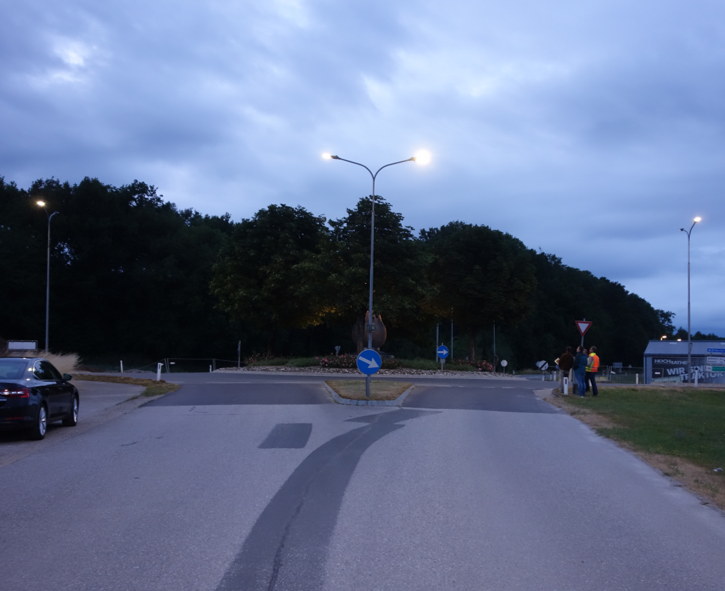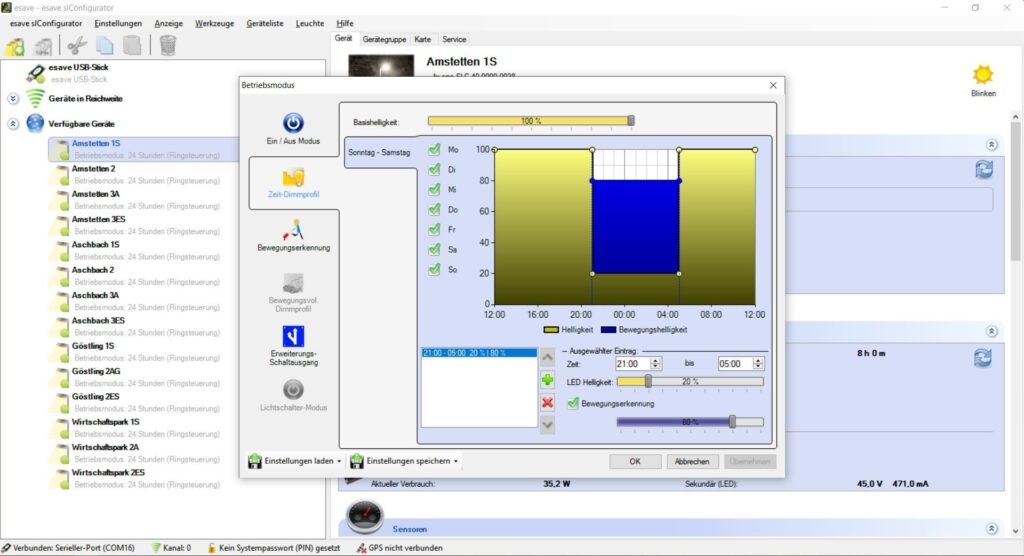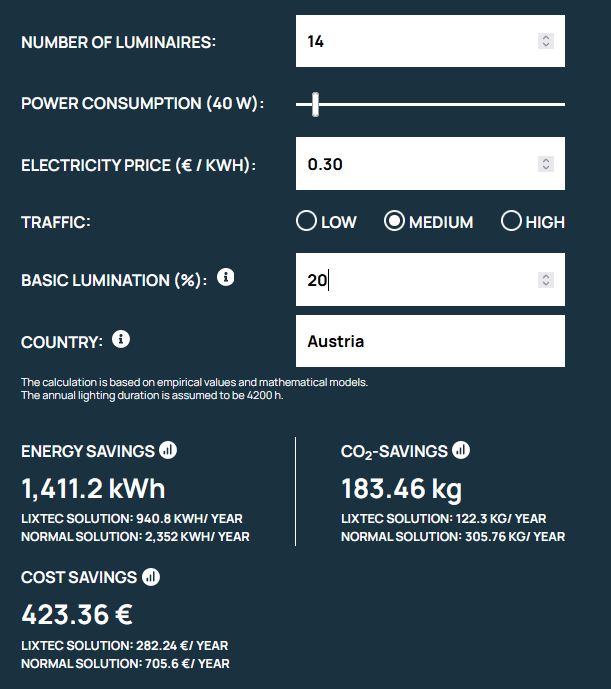Initial Situation
Roundabouts are considered a safe and climate-friendly alternative to regulated intersections. A trial in Germany even showed that the installation of a roundabout at a critical location reduced the number of accidents to zero. Ideally, a roundabout allows for fluid traffic and thus eliminates the need for starting and waiting, which has a positive effect on environmental and noise pollution. A disadvantage of this particular form of intersection is that it consumes more space than traffic light intersections. i
Another factor that argues for the installation of a roundabout is the saving of the traffic light system and the associated costs for maintenance and electricity. Especially in rural areas or on less frequented roads, it makes sense to dispense with traffic lights and let the traffic regulate itself.
In this application example, the roundabout is located in a green area and therefore light pollution should be considered in the lighting installation. There is potentially little traffic on the roundabout during the night hours. The exception to this is during the shift change period of a nearby business. Another aspect to consider in this case is the location of the intersection. It is inefficient for the road administration to routinely check the lights of all roundabouts.
i https://www.kfzteile24.de/magazin/ratgeber/kreisverkehr-verhalten-regeln
Solution Approach
In order to ensure standard-compliant lighting as soon as road users approach the roundabout and still use the lighting as efficiently as possible, demand-oriented street lighting is used. In this way, the aspects of reducing energy and costs are taken into consideration without sacrificing the safety aspect. Likewise, the use of the technology counteracts light pollution.
Both the sensors and the luminaire controllers are able to monitor the functionality of the luminaires. In this way, it is possible to determine whether the luminaires are working, the masts are straight, how much energy is saved and how long the remaining service life of the LEDs is, virtually via remote maintenance and without control trips.

Technical Implementation

Around a roundabout, relatively few light points are needed. In the present application, there are 14 of them, 8 of which are arranged in the inner circle and illuminate the entrance and exit roads, and the others are placed to illuminate the approach roads. On the outermost luminaires of the 4 approach roads and on the 4 entrance luminaires, one lix.one SLC radar sensor each is planned for motion detection and the remaining 6 luminaires are planned with the luminaire controllers “esave SLC Hub 103” as well as an “esave SLC Hub 103 GPS”. For the 8 luminaires with motion sensors, only ZHAGA interfaces on the underside are necessary, for the remaining 6 luminaires with controllers, only ZHAGA interfaces on the upper side of the luminaire head are necessary.
Installation
Configuration
By using an “esave SLC Hub 103” with GPS connection, the system can be provided with a time tag, which is essential for the configuration of the dimming profile. In addition, the installation was equipped with a test gateway to monitor the installation during the first months. As the client is equipping a roundabout with demand-responsive lighting control for the first time, the monitoring not only serves to monitor the luminaires, but also to record the energy statistics and the energy costs saved.
The standard-compliant lighting design of the project was carried out by the manufacturer of the luminaires used.
The luminaires are configured via the esave sIConfigurator. Parameters such as the basic lighting, the lighting level in the event of motion detection and the dwell time of the lighting can be configured via the configurator.
Due to the shift work of the nearby company and the regular traffic volume, the client of the project decides not to dim the luminaires until 9 pm and after 5 am. The following dimming profile is used between 9 p.m. and 5 a.m:
20 % of the light output in idle mode
80 % of light output for motion detection
Hold time after motion detection: 10 seconds
Due to the detection range of the radar sensors at the outermost light points of the approach roads, cars are detected up to 70 metres in front – for larger objects, the detection range is extended further. This implies that for cars, the roundabout is illuminated at least 9 seconds before they arrive. All luminaires are networked with each other, which means that the entire lighting of the roundabout is dimmed up.
2-in-1-Solution: Controller and Sensor
Radar sensors from lixtec (lix.one SLC and lix.detect SLC) make the simultaneous use of controllers unnecessary, as they can fulfil both functions. This has the advantage that only one ZHAGA interface is needed/occupied per light head.
In addition, the price for the controller can also be saved.
Energy Statistics & Monitoring
Since in this application the light output is only increased as needed during the night hours between 9 p.m. and 5 a.m., a representation using the energy calculator does not really reflect the real savings. This is because the times in full operation are not recorded – so the figures would still have to be corrected downwards.
The calculation is based on the assumption that lighting is provided as required throughout the night. The overview is intended to show how large the savings potential of a roundabout is in the ideal case.
A much more meaningful statistic is included in the energy statistics of the entire roundabout.


The graphical processing of the days from Sunday, 12.02.2023 to Thursday 16.02.2023 clearly shows those times when the system is operated at normal power. From 9 p.m. to 5 a.m., the energy consumption drops significantly; only on the night of Wednesday is there likely to have been wind or precipitation, which explains the increase in energy consumption due to activations.
Conclusio
If energy and costs are to be saved without sacrificing comfort and safety in street lighting, the use of motion sensors is essential. Even if the annual savings remain manageable due to the small number of luminaires in a roundabout, the aspect of reduced light pollution should not be disregarded.
Depending on the location of the roundabout and its accessibility, the possibility of monitoring the luminaires is an argument in favour of the use of light controllers for many planners. The wide detection range of radar sensors is what makes the use of this technology possible in the first place. If the distance is too short and the time required is too short, the road user might already be in the area of the circle before the light is dimmed up.